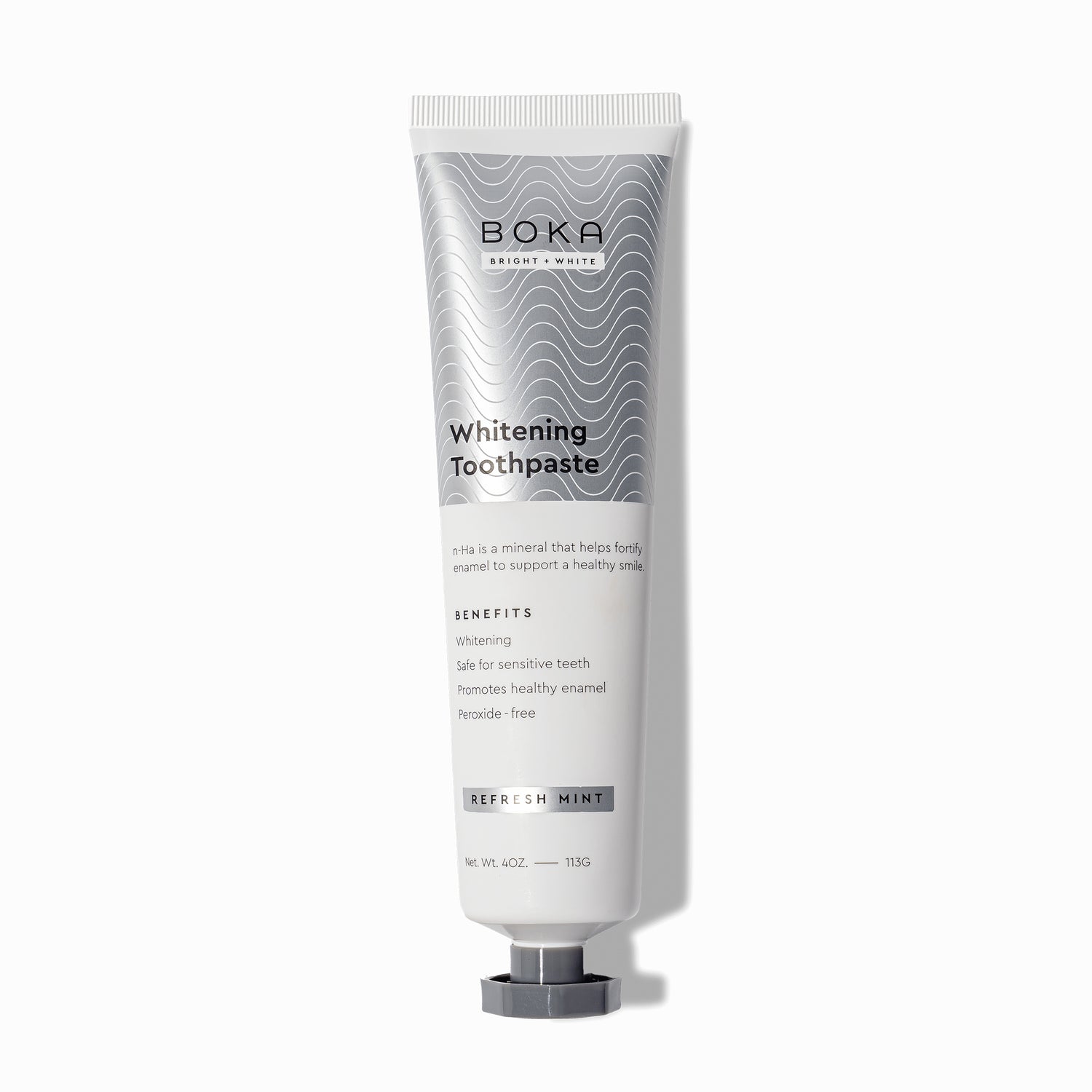Have you flossed yet today?
If you’re not on the flossing bandwagon yet, there’s no better time than the present!
Flossing is essential for maintaining a happy and healthy mouth. So, if you’re unable to see results from your flossing routine, you may want to consider changing the timing of each dental activity.
For example, have you ever thought about when to floss during your routine? Shockingly, it’s really important!
So, in this article, we’ll discuss:
- The benefits of flossing before or after you brush your teeth
- Expert opinions from medical associations, such as the American Dental Association
- Journal articles that will provide answers to this flossing dilemma.
Once you reach the end of this quick read, you’ll be able to floss confidently knowing that you’re getting the most out of your dental hygiene routine. Let’s begin!
Should you floss before or after brushing?
The order of flossing and brushing doesn't matter as long as you do a thorough job of both. What's most important is being consistent and making sure you floss all your teeth and brush for at least two minutes each time. Cater your routine to your specific needs and preferences.
Flossing contributes to good dental hygiene because it lifts and removes plaque and food in between your teeth. Brushing also removes plaque and food debris, but the bristles of a toothbrush can’t reach deep in between teeth to remove it all. Therefore, flossing helps keep your mouth as clean as possible.
So, make sure to floss every tooth (or as many as you can reach) and brush for a minimum of two minutes! Brush all sides of your teeth and floss as far back as you can reach with your fingers.
If you like to loosen food particles with floss and brush them away afterward (or if you use floss as a polishing tool after you brush), you’re doing it right (so long as you’re thorough!).
Additionally, it is important to cater your routine to your specific situation, such as with braces, implants, and other dental work.
Expert Opinions
Countless studies have shown that brushing and flossing are an essential part of dental care.
However, let’s take a closer look at what experts have to say about the order in which you brush or floss!
Dr. Anjum Chaudhary (BDS, MDS) recommends flossing before brushing for maximum benefits.
According to the American Dental Association (ADA), the order of brushing and flossing has no bearing on oral hygiene.
In fact, the most important aspects of oral hygiene are consistency and thoroughness.
Additionally, you should always floss when you brush (and vice versa) because it’s easy to forget to floss later in the day!
Daily use of floss is associated with a reduction in gingivitis and gum disease overall, which was established by Londero and their cohort in a study published in the Journal of Clinical Dentistry.
Specifically, these researchers found that in all 75 participants, flossing enhances the protective effects of toothbrushing on gingivitis.
In another analysis looking at timed flossing by Silva and colleagues, no plaque differences between the floss-brush and brush-floss groups were observed.
In another clinical trial study, the results showed that flossing followed by brushing is preferred to brushing than flossing in order to reduce interdental plaque and increase fluoride concentration in interdental plaque. In the floss-brush group, interdental and whole plaque were reduced significantly more than in the brush-floss group.
Is there a benefit of flossing before or after brushing?
Overall, there is no benefit when it comes to the order of your dental routine. So, as long as you make sure that every tooth is getting attention, your personal routine preferences should be prioritized.
In terms of preference, one of the most important things you can do is pick a toothpaste and floss combo that you love.
Check out our n-HA Toothpaste, as well as the Ela Mint Floss — they’re all great options! Also, this combo of dental products reduces the toxic effects of fluoride.
Additional tips
So now that you’re current on the recommendations for flossing and brushing, let’s explore some tips and tricks to maximize your oral hygiene.
First, we’ll check out how to brush effectively, and then move on to top flossing tips:
Effective Brushing
Brushing mechanically removes food debris from your teeth while also depositing toothpaste into your mouth for dental benefits.
However, you can brush your teeth too harshly, depending on the amount of force applied and the toothpaste used.
Use a soft-bristled toothbrush
Soft-bristle toothbrushes are great for two reasons: firstly, they’re gentle on your gums, which contain many blood vessels that keep your teeth safe and healthy.
Secondly, the soft bristles more easily wedge into tight areas around the tooth and remove hard-to-reach food particles.
You can try our toothbrushes that have activated charcoal bristles, which are silky-soft and able to effectively eliminate bacteria that causes bad breath while providing a gentle and thorough clean.
Brush for at least two minutes
“Two minutes… really?”
Yes, really! Brushing is not a perfect science, which means that it's susceptible to human error.
If you’re encouraged to brush for two or more minutes, you may find that you pay attention to areas that usually don’t get as much love (such as your gums, tongue, and back molars).
A study recommended that oral health care professionals should reinforce efforts to persuade patients to brush for longer periods of time, as increasing brushing time to the consensus minimum of 2 minutes from a more typical 45 seconds increases plaque removal to an extent likely to provide clinically significant oral health benefits.
Brush all tooth surfaces (front, back, and chewing surfaces)
Although we mostly see the front of our teeth, you should always aim to include the backs and tops of your teeth as well!
Importantly, cavities form on the tops of your molars, usually in their ridged surfaces.
If you prioritize cleaning the tops of your molars, you’re more likely to remove sugary food debris and may reduce your risk of cavities in the future.
Use gentle, circular motions
Gentle is the key word! Engaging in gentle, yet meticulous brushing is the best way to fully clean your mouth and to avoid brush-induced damage to your gums and teeth.
Angle the brush at 45 degrees towards the gum line
If you angle your brush towards your gum line, you will effectively clean your gums without brushing your gums excessively.
If the gums are brushed too aggressively, this can lead to eroding and gum recession, in more severe cases.
Gum recession refers to the loss of tissue along the gumline. When gum recession occurs, the gum tissue will not return on its own. This leads to the exposure of the tooth roots. The tooth roots are meant to be hidden by the gumline.
Brush your tongue and the roof of your mouth
Your mouth contains millions of microscopic organisms (bacteria, mostly) that can help or hinder your oral hygiene. How cool!
However, these little guys live everywhere in your mouth – including on the roof of your mouth and on your tongue. Therefore, it’s important to brush your entire mouth to remove the bad bacteria and keep the good ones!
Always keep in mind to replace your toothbrush every three or four months or sooner if the bristles are frayed. A worn toothbrush won’t do a good job of cleaning your teeth.
Effective Flossing
Next, let’s talk about flossing. Flossing is a tremendous way to get into sneaky areas of your mouth and enhance the completeness of your dental routine.
Interdental cleaning helps remove debris and interproximal dental plaque, the plaque that collects between two teeth; dental floss helps clean these hard-to-reach tooth surfaces and reduces the likelihood of gum disease and tooth decay.
The U.S. Department of Health and Human Services also reaffirmed flossing as "an important oral hygiene practice" in an August 2016 communication to ADA News.
We’re here to provide you with some excellent pointers that will help you achieve a better flossing experience.
Use a piece of floss about 18 inches long
Have you ever grabbed a piece of floss and – despite knowing it was too short – tried to use it? What a frustrating experience!
So, the rule of thumb for floss length is 18 inches (or the length of a rolling pin). Did you know that a giraffe’s tongue is also 18 inches long?
Hold the floss tightly between your thumb and fingers
If you’re able, wrap the floss around your thumb and finger (without cutting off circulation, of course).
This setup will ensure that your line of floss is tight and immobile. When the floss is in a stable position, it’s easier to maneuver and remove plaque!
Gently slide the floss between your teeth
It’s always a good idea to floss in front of a mirror, especially if you’re having trouble getting floss between your teeth. Remember to be gentle, as your gums are right there!
Curve the floss around each tooth in a "C" shape
Your floss should move around between your teeth to catch all of the food debris that it can hold.
While moving the floss in a straight line is a good idea, you will want to curve the floss for greater flossing coverage between your teeth.
Slide the floss up and down against the tooth and just below the gum line
Make sure to cover the entire tooth, even close to the gumline, to remove any unwanted particles or plaque.
Especially if your gums are inflamed, removing these irritants can do wonders for gingivitis and general periodontal disease.
Use a clean section of floss for each tooth
Do not reuse floss. Instead, grab a clean section each time you floss! Floss comes in a variety of flavors and packaging, so finding one that you love will help you to be consistent.
Your overall health can benefit from a clean mouth, so if you're unsure which toothpaste/floss/toothbrush combo to try, browse our wide range of oral care products.
Closing Remarks
You’re well on your way to becoming an excellent brusher and flosser!
Remember: brush and floss, your teeth, in whatever order feels right for you, just make sure to do a really good job — your teeth are counting on you. Take care!


